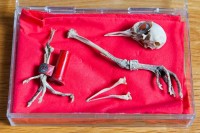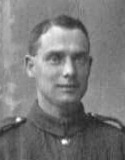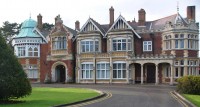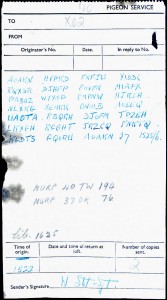 In 1982, David Martin and his wife Anne were renovating the fireplace in their 17th century house in Bletchingley, Surrey. The fireplace had been sealed off for many years, and the Martins wanted to restore it to its former functional splendor. They removed the asbestos protective liner and behind it found the original Victorian fireplace. Excited by the find, they began to clear out the chimney, which had for years been the home of birds who had packed it with twigs and nesting materials. As they pulled out the twig stuffing, bird bones came down with it, first a breastbone, then a skull, then a leg with an aluminium ring around it. The ring made them realize these weren’t the remains of a lazy old nesting bird, but rather a gainfully employed one like a racing pigeon. Then the second leg came down and it had a red plastic capsule attached to it. The red color of the capsule marked the bird as a military carrier pigeon for the Allied Forces in World War II.
In 1982, David Martin and his wife Anne were renovating the fireplace in their 17th century house in Bletchingley, Surrey. The fireplace had been sealed off for many years, and the Martins wanted to restore it to its former functional splendor. They removed the asbestos protective liner and behind it found the original Victorian fireplace. Excited by the find, they began to clear out the chimney, which had for years been the home of birds who had packed it with twigs and nesting materials. As they pulled out the twig stuffing, bird bones came down with it, first a breastbone, then a skull, then a leg with an aluminium ring around it. The ring made them realize these weren’t the remains of a lazy old nesting bird, but rather a gainfully employed one like a racing pigeon. Then the second leg came down and it had a red plastic capsule attached to it. The red color of the capsule marked the bird as a military carrier pigeon for the Allied Forces in World War II.
“I wonder if there’s a secret message,” mused Mrs. Martin, and lo and behold, when they unscrewed the capsule they found a secret message inside. It was written in code, 27 groups of five letters or numbers, on thin paper the size of a cigarette paper. The only parts immediately readable were the number of copies sent (two; the copy went by this one’s companion bird) and the name of the sender, Serjeant W. Stot (the “j” in “serjeant” suggests Stot was with the RAF rather than the Army, which usually spelled the rank with a “g”) [EDIT: The so-called expert in the article who made this claim was wrong. “Serjeant” is associated with the Army.)
The Martins showed the message to a neighbor of theirs, Secret Agent Commander Wilfred “Biffy” Dunderdale, a counter-espionage specialist who had worked for the British Secret Intelligence Service between 1921 and 1959. A lover of fast cars and faster women, Dunderdale was the Paris station chief for SIS (later called MI6). He was a regular for lunch at  Maxim’s, wore bespoke suits and solid gold Cartier cufflinks, smoked Balkan brand cigarettes in a long black ebony holder and drove a massive armour-plated Rolls-Royce around town while working (theoretically) undercover. Ian Fleming, then a rookie Naval Intelligence operative, met Dunderdale in Paris in 1940. After the war they were members of the same club, Boodle’s in St. James’s Street, where Dunderdale would regale the assembled with tales of his daring exploits. His larger-than-life personality and adventures, including smuggling two German Enigma encoding machines from Poland to Paris to London in 1939, were among Fleming’s sources for the character of James Bond.
Maxim’s, wore bespoke suits and solid gold Cartier cufflinks, smoked Balkan brand cigarettes in a long black ebony holder and drove a massive armour-plated Rolls-Royce around town while working (theoretically) undercover. Ian Fleming, then a rookie Naval Intelligence operative, met Dunderdale in Paris in 1940. After the war they were members of the same club, Boodle’s in St. James’s Street, where Dunderdale would regale the assembled with tales of his daring exploits. His larger-than-life personality and adventures, including smuggling two German Enigma encoding machines from Poland to Paris to London in 1939, were among Fleming’s sources for the character of James Bond.
After he retired from the Service, Biffy moved a few doors down from the Martins in Bletchingley.
Mr Martin recalls: “When I showed him the bird and code the blood drained from his face and he advised us to back off. He said nothing would ever be published.”
Can you even stand how juicy that is? I cannot. I cannot stand how juicy that is.
Anyway, it seemed that Biffy’s dire prognostication might come to pass as the years went by and nobody official could be persuaded to give a damn. In 1982, Britain was mired in the Falklands War and they weren’t interested in figuring out what a now-dessicated carrier pigeon had been trying to tell them 40 years earlier. It was the pigeon fancier community, from the Royal Pigeon Racing Association to military carrier pigeon aficionados, that kept hope alive, working for years to get the government to pay attention to this find.
 Two years ago, Bletchley Park, the headquarters of British Intelligence codebreakers during World War II and now a museum, took an interest in the message. Although they have not yet broken the code, they have found out that this message is something special. Bletchley Park had a classified MI6 pigeon loft during the war, but none of its messages were sent in code. Colin Hill, curator of Bletchley Park’s permanent Pigeons at War exhibition, said all of the pigeon messages they have in their archives were written longhand. That means this bird was carrying a message more secret than the actual codebreakers’ messages.
Two years ago, Bletchley Park, the headquarters of British Intelligence codebreakers during World War II and now a museum, took an interest in the message. Although they have not yet broken the code, they have found out that this message is something special. Bletchley Park had a classified MI6 pigeon loft during the war, but none of its messages were sent in code. Colin Hill, curator of Bletchley Park’s permanent Pigeons at War exhibition, said all of the pigeon messages they have in their archives were written longhand. That means this bird was carrying a message more secret than the actual codebreakers’ messages.
Also, underneath the coded message are two lines which note the code numbers of two birds. NURP 40TW194 and NURP 37DK76 were the military carrier pigeon which landed in the Martins’ chimney and its companion bird who would have carried the same message. The fact that they doubled up underscores how important this top secret message must have been, as does the complete absence of either of these birds’ code numbers from the historical archives. The birds themselves were top secret!
 Bletchingley is half-way between the beaches of Normandy and Bletchley Park, a suitable spot for a weary pigeon hero to have a rest on a chimney top only to find himself overcome by the fumes and fall inside. It’s also only five miles from Field Marshal Montgomery’s headquarters at Reigate, Surrey, where he planned the D-Day landings at Normandy. Given Winston Churchill’s insistence on a complete radio blackout for the D-Day operations, this pigeon could well have been carrying a message for the general from the front lines at Normandy.
Bletchingley is half-way between the beaches of Normandy and Bletchley Park, a suitable spot for a weary pigeon hero to have a rest on a chimney top only to find himself overcome by the fumes and fall inside. It’s also only five miles from Field Marshal Montgomery’s headquarters at Reigate, Surrey, where he planned the D-Day landings at Normandy. Given Winston Churchill’s insistence on a complete radio blackout for the D-Day operations, this pigeon could well have been carrying a message for the general from the front lines at Normandy.
When they realized the message was unique and potentially of great historical significance, Bletchley Park curators sent it to Government Communications Headquarters (GCHQ) so the current crop of codebreakers could set about deciphering it. Now that this story has finally made the press, GCHQ has been asked for any further information they might have about the message. They won’t comment on it, even on whether it was top secret, until the code is broken.
The National Pigeon Service deployed 250,000 pigeons to send messages during World War II. Thirty-two of them received the Dickin Medal, the highest possible decoration for valor that can be awarded to an animal. Perhaps 40TW194 can be posthumously granted the medal for giving his life in service to his country.
This BBC story starts with a nice period Pathé newsreel about the pigeon squadrons, then moves on to the Martins’ fireplace and the historical treasure within.
[youtube=http://www.youtube.com/watch?v=fkYhb-vobBw&w=430]
What an amazing story.I was intriqued from start to finish.Most people think pigeons are messy birds.However, I have always been interested in them for this very reason..carrying urgent messages.Can you tell me who first discovered their ability for this.An interesting subject I think. A fantastic find for the couple who found the message in their chimney. Many thanks for sharing.
Homing pigeons are domesticated version of wild rock pigeons which have an innate ability to find their way back home from great distances. The ancient Egyptians are known to have used pigeons to carry messages. I suspect there’s no one person responsible for recognizing the usefulness of the trait, but rather several populations making the same realization and beginning a selective breeding program, much like with the domestication of the dog and cow.
Has anyone tried to track down Serjeant W. Stot? That might shed some light on it. Where was he on D-Day?
Waidmann
Excellent point. Google is of no help since every mention of him right now is in the context of the pigeon story, but surely the military archives have that information.
That’s what I was thinking. Although, one possibility is that if he was a spook of some sort, Stot might have been a code name of some sort.
Waidmann
Absolutely fascinating! During WWII in the European theater my father-in-law was involved in something he can’t talk about. Since he doesn’t have a computer, I’ve printed out the article to send to him. This may be the incentive he needs to let us give him an iPad!
This is a fascinating story! I hope you’ll give us an update when the code is deciphered. I wonder if the second pigeon completed his mission successfully.
I will certainly update as soon as the code is cracked, or at least as soon as they tell the rest of us. 🙂
Just fascinating, and love the mystery of it.
To me the most intriguing mark on the paper is the unnecessary slash under “Time of orig,” which might mean to use a certain variation of the code.
Pure speculation, of course, but that’s part of what makes this such an interesting story.
Looking forward to hearing what they make of it.
Ohhh, please!!! Follow this story. I thought they had decoded the message already!!
So intriguing.
I will be mildly amused if the code says “If this pigeon is lost, please return to: Serjeant W. Stot”
For Sebastían and anyone else awaiting details on this one:
http://phys.org/news/2012-11-uk-codebreakers-stumped-wwii-pigeon.html
Seems the crypotgraphers aren’t making much headway on the message, but they’ve released it to the general public. The article has a photo of the message!
Come on John Nash, we need you.
Serjeant William Stott of the Royal Australian Air Force was a wireless operator in a Liberator bomber (note Lib-1605 in bottom left of message full picture). On a sub hunt with his famous squadron 120 RAF out of Iceland, his Liberator was transmitting a message, “Beginning to attack” when the radio message faded and lost. He was Missing and presumed dead. His squadron did sink a U boat that day, part of a hunter pack they intercepted. He was promoted posthumously to Warrant Officer. He’s listed in the Australian War archives online.
Chances are if the government ever found out the meaning they would not release it as it is supposed to be “top secret” and our governments corrupt anyway, there are so many things we do not know and that they hide from us, not trying to sound like some huge conspiracy theorist or anything but I’ve been thinking things over the last while and checking things out. There are so many unexplained events in the world that should have simple explanations .. I’m not knocking anyone in the military believe me when I say I have nothing but respect for all those brave men and women who protect our countries and our families. This is just my two cents on some subjects. Everybody has their own opinion and I respect that aswell.
If Rt ey ey cu nv x BEG.
SubSrUs Bremer IINRF.
Your words makes more sense of the msg
I got from code.
Would be interesting to know more of this crews actions June 26-27 1942.
A fascinating story, I would love to hear more. I note the comments of Lane Gruenwald above re Sjt W Stott and his connection to Liberator bombers, but I had considered that the term ‘lib. 1625’ meant…liberated… as in set free or released – thye time the bird was released which would correspond in someway to the ‘Time of origin’ of the message which was 1522…just over an hour before. If someone has ancestory.com surely research could get further with Sjt Stott. Can anyone explain the basics of such a code…is each separate letter representing a different separate letter…are the spaces between the 5 letter blocks also representing a letter…does anyone know a little more about this type of code.
looks to have been sent from Bremen confluence: 8 degrees 52′ 22′ east
http://wn.com/1000_plane_raid_june_26_1942
bremem was approx 75 minutes from england
Our great uncle Earnest Arthur Mincham was on the same ill-fated Liberator mission as William Stott (Australian). They were good friends. If this message is written by William Stott, it would be amazing to know.
We are trying to track down Stott’s relatives in Australia as we have so much to share about the Liberator flight. If anything comes, to light about this pidgeon message and it is indeed the William Stott we are looking for, please let us know.
7 people wear a coat Ni Ni eats Zhuangshan this bowl of rice
Hello Irene, I am William Stott’s granddaughter and have been researching him on the internet when I came across this interesting story and your comment. I would apppreciate any information you have about the Liberator flights that I believe your Uncle and my Grandfather shared. I have come across one photo of them together. If you would like my email address please respond. Thank you.